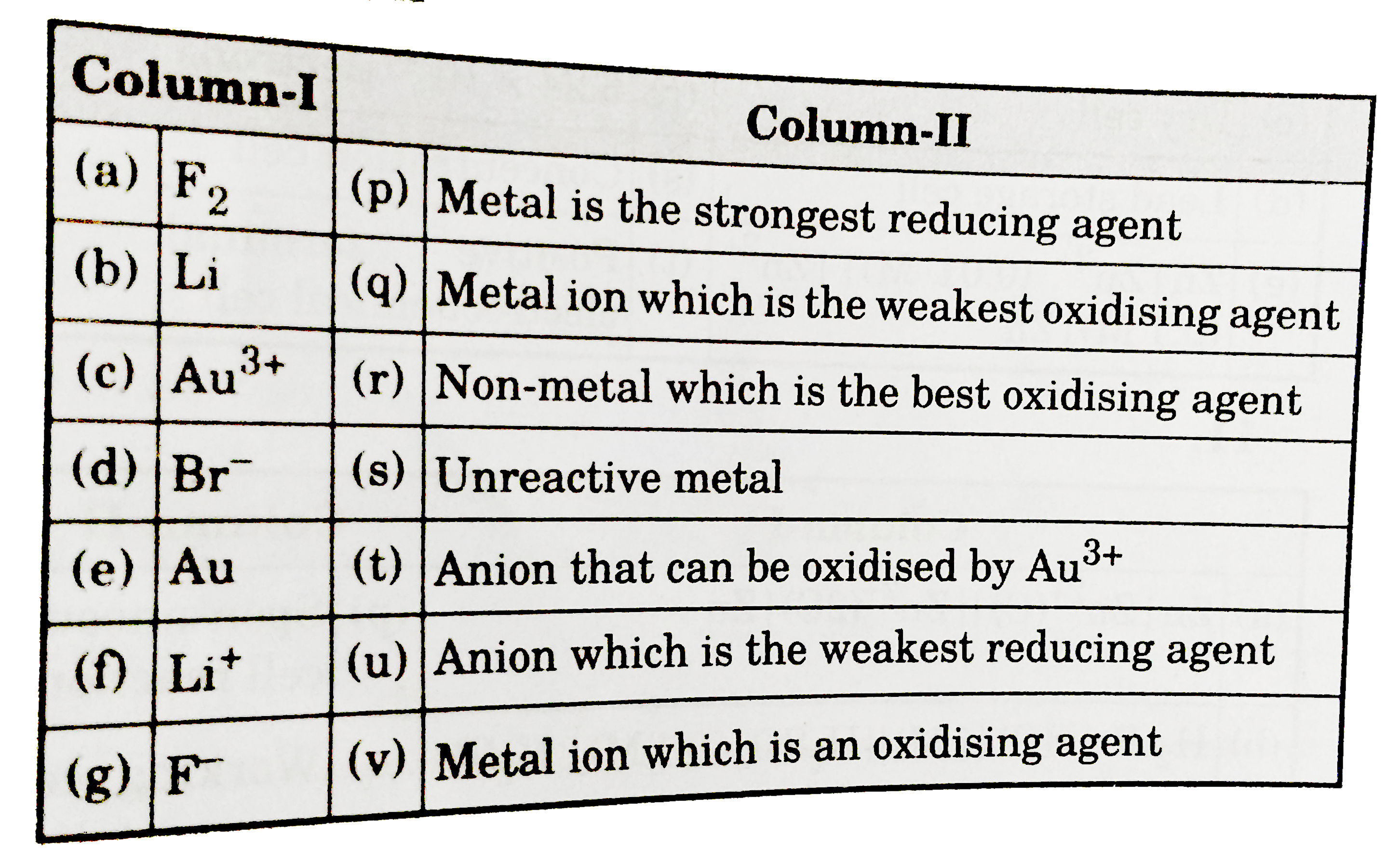Match the items of Column I and Column II on the basis of data given below:
(One to one match only)
E∘F2∣F− = 2.87 V, ELi+∣(Li) = -3.5 V,
E∘Au3+∣Au = 1.4 V, E∘Br2∣Br− = 1.09V

A. F2 is a non-metal and best oxidising agent because SRP of F2 is +2.87V
B. Li is a metal and strongest reducing agen t because SRP of Li is -3.05V
Au3+ is a metal in which is an oxidisng agent as SRP of Au3+ is +1.40V
D. Br− is an anion that can be oxidised by
Au3+ and Au3+(E∘=1.40) is greater than
Br−(E∘=1.09V).
E. Au is an unreactive metal .
F. Li+ is a metal ion having least value of SRP(-3.05V), hence it is the weakest oxidising agent.
G. F− is an anion which is the weakest reducing agent as F−/F2 has low oxidation potential (−2.87V).
Topper's Solved these Questions
- D AND F-BLOCK ELEMENTSBOOK - NCERT EXEMPLARCHAPTER - D AND F-BLOCK ELEMENTSEXERCISE - D And F-Block Elements
71 Videos
- GENERAL PRINCIPLE AND PROCESSES OF ISOLATION OF ELEMENTS BOOK - NCERT EXEMPLARCHAPTER - GENERAL PRINCIPLE AND PROCESSES OF ISOLATION OF ELEMENTS EXERCISE - General Principle And Processes Of Isolation Of Elements
55 Videos
Similar Questions
Match the items of Column I and Column II on the basis of data given below :
E_(F_(2)//F^(-))^(Ï´)=2.87" V ",E_(Li^(+)//Li)^(Ï´)=3.5" V ",E_(Au^(3+)//Au)^(Ï´)=1.4" V ",E_(Br_(2)//Br^(-))^(Ï´)=1.09" V "

View SolutionSelect the correct statement if-
E∘Mg2+/Mg=−2.4V,E∘Sn4+/Sn2+=0.1V,E∘MnO−4,H+/Mn2+=1.5V,E∘I2/I−=0.5V
View Solution
Knowledge Check
If E∘Au+/Au is 1.69 V and E∘Au3+/Au is 1.40 V, then E∘Au+/Au3+ will be :
A0.9 vB0.945 VC1.255 VDNone of theseAn aqueous solution containing 1M each of Au3+,Cu2+,Ag+,Li+ is being electrolysed by using inert electrodes. The value of standard potentials are :
E∘Ag+/Ag=0.80V,E∘Cu+/Cu=0.34V and E∘Au+3/Au=1.50,E∘Li+/Li=−3.03V
will increasing voltage, the sequence of deposition of metals on the cathode will be :ALi , Cu , Ag , AuBCu , Ag , AuCAu , Ag , CuDAu , Ag , Cu , LiArrange the following metals in increasing order of their reducing power.
[ Given : E∘K+/K=−2.93V,E∘Ag+/Ag=+0.80V,E∘Al3/Al=−1.66V,E∘Au3+/Au=+1.40V,E∘Li+/Li=−3.05V]ALi<K<Al<Ag<AuBAu<Ag<Al<K<LiCK<Al<Au<Ag<LiDAl<Ag<Au<Li<K
Four different solution containing 1M each of Au+3,Cu+2,Ag+,Li+ are being electrolysed by using inert electrodes. In how many samples, metal ions would be deposited at cathode?
[Given :E0Ag+/Ag=0.8,E0Au+3/Au=1.00V
E0Cu+2/Cu=0.34V,E0Li+/Li=−3.03V]
View SolutionStandard reduction potentials of the half reactions are given below:
F2(g)+2e−→2F−(aq):E∘=+2.85V
Cl2(g)+2e−→2Cl−(aq),E∘=+1.36V
Br2I+2e−(aq):E∘=+1.06V
I2(s)+2e−→2l−(aq):E∘=+0.53V
The strongest oxidising and reducing agents respectively are:
View SolutionStandard reduction potentails of the half reactions are given below:
F2(g)+2e−→2F−(aq.),,Eɵ=+2.87
Cl2(g)+2e−→2Cl−(aq.),,Eɵ=+1.36V
Br2(g)+2e−→2Br−(aq.),,Eɵ=+1.09V
I2(s)+2e−→2l−(aq.),,Eɵ=+0.54V
The strongest oxidizing and reducing agents respectively are:
View SolutionOn the basis of data given below,
E∘Sc3+/Sc2+=−0.37V,E∘Mn3+/Mn2+=+1.57V
E∘Cr2+/Cr=−0.90V,E∘Cu2+/Cu=0.34V
which of the following statements is incorrect?
View SolutionThe E∘ values of redox complex of halogens are given. Based on these values mark the correct statement.
E∘I2/CI−=+0.54V,E∘Br2/Br−=+1.08V,
E∘Cl2/Cl−=+1.36V,
View Solution
